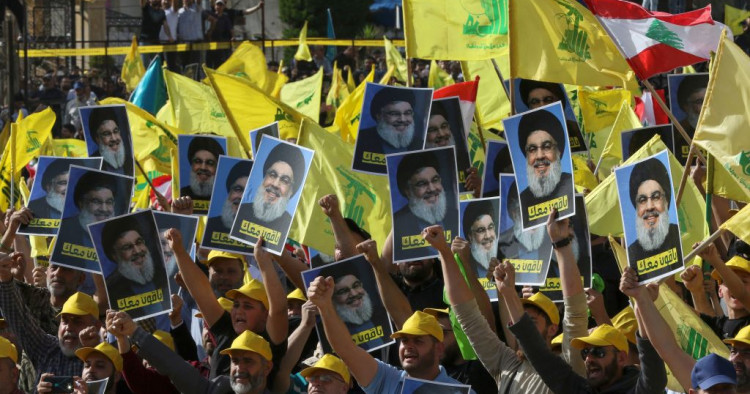Contents:
- Four key dynamics to watch as Lebanon heads to the polls
- The Middle East’s rising importance in geopolitics and US foreign policy
- As Assad visits Tehran, Syria’s humanitarian crisis looks set to worsen
- Amid an unpredictable market, OPEC+ is likely to maintain its approach
- Dust storm season in the Arabian Peninsula starts early and aggressively in Iraq
- Worsening Afghan-Iranian relations add to the Taliban’s woes
- Amid growing security challenges, troubling signs of things to come in Afghanistan
Four key dynamics to watch as Lebanon heads to the polls
Randa Slim
Senior Fellow and Director of Conflict Resolution and Track II Dialogues Program

Lebanese expatriates cast their votes in 59 countries this past week. According to information reported by the Lebanese Ministry of Foreign Affairs, turnout reached close to 60% of registered voters, three times the expatriate turnout in the 2018 elections. The expatriates’ ballots will be shipped by DHL to Lebanon and kept in storage at the Central Bank until May 15, when voters in Lebanon cast their votes. Concerns have already been raised about the transparency of the process and how the ballots will be gathered, shipped, and stored until election day, when they will be opened and distributed to the voters’ electoral districts for tabulating.
Will higher expatriate turnout be a harbinger of what to expect on May 15, when residents cast their ballots? In 2018, voter turnout was 49.7%. Public opinion polls have been contradictory. Some show a higher level of enthusiasm among voters while others indicate disillusionment and apathy, which will likely lead to lower turnout. It is also not clear whether higher voter turnout will benefit the independent candidates and civil society activists who rose to prominence in the October 2019 protests or reaffirm the hold that traditional parties have so far maintained over the Lebanese electorate.
In addition to voter turnout levels on May 15, there are four key dynamics to track as the results are announced:
- How large is the Free Patriotic Movement’s (FPM) loss in Christian districts and which other Christian parties and candidates will it benefit? Public opinion polls indicate that of the ruling political parties contesting these elections, FPM will likely lose the most seats. Which other parties will secure the largest share of the disenchanted vote? Will it go toward other traditional Christian parties, including the Lebanese Forces and the Phalanges, or will it benefit independent Christian candidates?
- How large is the Sunni boycott? According to some public opinion polls, close to 30% of Sunni voters are planning to boycott the elections. With Saad Hariri’s exit from the political scene, choosing to boycott the elections is either about showing loyalty to Hariri or a reflection of broader disillusionment among Sunni voters with their political leaders, whom they blame for the economic crisis and their failure to rein in Hezbollah. A large Sunni boycott will likely translate into additional seats in parliament for Hezbollah and their allies.
- Will Hezbollah and Amal maintain their hold on Shi’a voters or will we see a win by one or two independent Shi’a candidates? Were I a betting person, I would wager on the former, not the latter.
- How many independent candidates will win overall? In 2018, only one independent won. A win by 10-12 independents this time will be considered a major achievement given the many obstacles they face, including threats and attacks by supporters of the ruling elites, the well-oiled political machines of the traditional parties, and their own internal divisions, which led to their fielding several competing lists instead of presenting a unified front to Lebanese voters. They are hoping that public anger against the political status quo will be sufficient enough to overcome these obstacles and help them secure this electoral feat.
Follow on Twitter: @rmslim
The Middle East’s rising importance in geopolitics and US foreign policy
Brian Katulis
Vice President of Policy

G-7 countries committed to banning or phasing out Russian oil this weekend, a move that will reshape global energy markets and the broader international system if it is fully implemented. The G-7 statement is the latest effort by a group of countries to respond to Russia’s war against Ukraine and the latest indication of an international system re-arranging itself in unanticipated ways as a result of the Ukraine war and pre-existing trends in globalization.
The Biden administration is understandably overwhelmed with the Ukraine crisis. The administration is also sharpening its focus on China and Asia this month, as well, with President Joe Biden traveling to Japan and South Korea after hosting Association of Southeast Asian Nations (ASEAN) countries in Washington.
Even with its bandwidth considerably strained by Russia and China, the United States should remain engaged in the broader Middle East and North Africa (MENA) for three main reasons.
- The region remains vital to energy markets and the global economy. With gas prices nearing record highs in America, global energy dynamics are in a complicated phase. The plans for a transition to greener energy were already complicated before the Ukraine war and have only grown more so as countermeasures against Russia roil energy markets. Implementing a smooth energy transition will require more stable relationships with a broad range of actors across the Middle East. The energy needs of Europe will require greater diversification, including from sources in MENA, and it will take time to implement those plans.
- The human security challenges emerging inside MENA are not likely to stay within the region’s borders. Food and energy price increases are already impacting the poorest and most vulnerable populations across the region in ways that appear strikingly similar to the run-up to the 2011 popular uprisings that topped several governments. Add to these economic and social demands and growing challenges with water security and climate change and this could put even more pressure on a region of the world already facing a strained state system, conflict, and a refugee and migration crisis.
- Insecurity and tensions remain present across the regional system. Compared to the hot war in Ukraine, the Middle East seems relatively quiet right now, but tensions remain high. There are ongoing threats from terrorist networks in Afghanistan, Syria, and Yemen (among other places), unresolved questions about Iran’s nuclear program, and a regular stream of low-level conflicts among countries could easily spiral out of control, from the Israeli-Palestinian front to the Gulf and within other fragile countries.
The Biden administration came into office more than a year ago hoping to prioritize considerable domestic challenges and bigger-picture global issues such as climate change and COVID-19. But this uncertain picture across the broader MENA region requires more diplomatic attention from the United States in the next year and an approach that links the broader strategic challenges in the world involving Russia and China with a more coherent, steadier engagement in the Middle East.
Follow on Twitter: @Katulis
As Assad visits Tehran, Syria’s humanitarian crisis looks set to worsen
Charles Lister
Senior Fellow, Director of Syria and Countering Terrorism & Extremism programs

Syrian President Bashar al-Assad visited Iran on Sunday, in a rare foreign trip that saw him meet with Supreme Leader Ali Khamenei and President Ebrahim Raisi before swiftly returning to Damascus just hours later. “The respect for Syria is much higher now than in the past, and everyone looks at this country as a power,” Khamenei was quoted as saying — in a room adorned with the Iranian flag and a portrait of Ruhollah Khomeini, and no sign whatsoever of anything representing Syria. While Assad was quoted thanking Iran for its “strategic” support in pursuit of the “spirit of resistance” against Israel and the United States, Khamenei issued a stinging attack on regional states that have normalized ties with Israel — a pointed reference to the United Arab Emirates, which Assad visited on March 18.
Assad’s brief foray to Tehran came just six weeks after Iran’s Foreign Minister Hossein Amir-Abdollahian had visited Damascus, on the eve of Russia’s invasion of Ukraine. In the weeks since, some have speculated that Iran may have been delicately taking advantage of Russia’s acute distractions elsewhere and maneuvering itself back into positions of deeper influence in Syria. Indeed, Iran continues to reinforce its military deployments on Syrian soil — as a flurry of recent Israeli airstrikes have clearly suggested — and economic investments continue to trickle in, in Damascus, Aleppo, and Homs. Assad’s appointment of Ali Mahmoud Abbas as Syria’s new minister of defense on April 28 sent similar signals, given his deeper institutional ties to Iran than previous appointees, who have traditionally been loyal partners of Russia’s military.
While Assad was in Tehran, the international community was preparing for this week’s Brussels Conference, where governments will donate toward the collective humanitarian effort for Syria. In 2021, the international community provided over $2 billion to Syria aid — 0.17% of which was donated by Russia and Iran. Twelve years in, Syria remains the world’s most acute humanitarian crisis and the needs of Syrians have never been greater than they are today, with 14.6 million people (70% of the population) requiring aid to meet their basic needs. With the war in Ukraine, it is unlikely the world will even come close to providing what is needed to stem human suffering across Syria.
To make matters worse, Russia is now widely expected to veto a U.N. Security Council resolution in July that permits cross-border humanitarian aid to roughly 4 million civilians in acute need in Syria’s northwest. As chair of the U.N. Security Council this month, U.S. Ambassador Linda Thomas-Greenfield looks set to highlight the need for continued cross-border access, including through a visit to the Syrian-Turkish border later this month. The loss of access would spark an unprecedented humanitarian catastrophe.
Follow on Twitter: @Charles_Lister
Amid an unpredictable market, OPEC+ is likely to maintain its approach
Nikolay Kozhanov
Non-resident Scholar

Ongoing discussions over a sixth EU sanctions package against Russia did not prompt OPEC+ members to reconsider their policy toward increasing production quotas for June 2022 above 432,000 barrels per day (bpd). OPEC Secretary-General Mohammad Barkindo even argued that his organization is unable to replace the 7 million bpd of Russian oil that could potentially disappear from the market, although he was probably stretching the truth. While potential sanctions will, indeed, affect all Russian oil exports, they will only remove about 3 million bpd imported by the EU relatively quickly. As it so happens, this is the volume that OPEC+ countries — primarily Saudi Arabia, the UAE, Iraq, and Kuwait — can provide.
Yet neither Saudi Arabia nor other OPEC+ members should be suspected of pro-Russian sentiments. Rather, they do not want to spoil relations with Russia while it remains a major player in the market. However, this may not be the case for long, as the country is forced to reduce production volumes and will probably not be able to restore them soon. But Moscow’s problems are only part of the equation and cartel members’ actions are shaped by other considerations.
Firstly, the oil market remains unpredictable. As a result, it is important for oil producers to preserve OPEC+ as an instrument of influence on the price environment, which, to a large extent, is ensured by maintaining discipline within the cartel. Only the aforementioned four countries have free capacity and it is they who will profit from an increase in production volumes, while the other members will suffer losses due to the inevitable fall in oil prices.
Secondly, OPEC+'s free production volumes themselves represent a tool for influencing the market. Sacrificing them now for the interests of consumers seems impractical when the cartel predicts an oversupply will continue. Current realities also give little reason for optimism about reducing the impact of COVID on the world economy — especially on China — or about the pace of global economic growth. Both of these are crucial for the future of the oil market.
Thirdly, Vladimir Putin's war in Ukraine presents a rare opportunity for OPEC+ countries to enrich themselves. Oil prices driven up by Russia’s aggression against Ukraine have not only replenished coffers emptied by COVID, but they have also positively affected macroeconomic growth indicators. The need for international oil companies to leave Russia has also made them re-consider their presence in the Middle East and North Africa and could prompt them to expand their activities with the region’s national oil companies. Taking into account potential European sanctions, it is hard to see Gulf oil producers’ presence being seriously challenged by new Urals volumes in Asia. On the contrary, even China is showing hesitation regarding oil cooperation with Russia. In Europe, Russia's withdrawal also provides opportunities. The Gulf producers will only need to readjust their pricing policy, a process that Saudi Arabia, in principle, has already begun by reducing June prices for Europe and Asia.
Finally, the Arab oil producers in the Gulf have so far developed a very detached perception of the threats created by the current market environment. Concerns about the threat of inflation, rising input costs, and a potential slowdown in the non-oil sector are drowned out by the ringing of oil revenues. The prospects for proposed U.S. legislation targeting the cartel on anti-trust grounds, known as NOPEC, are also still vague, which allows Saudi Arabia to remain deaf to America’s calls.
As a result, unless any new "black swans" emerge in the oil market, OPEC+’s policy is unlikely to change before the current agreement expires in autumn 2022.
Follow on Twitter: @KozhanovNikolay
Dust storm season in the Arabian Peninsula starts early and aggressively in Iraq
Mohammed Mahmoud
Senior Fellow and Director of the Climate and Water Program

On Thursday, May 5, Iraq was once again engulfed by a severe dust storm that blanketed portions of the country, including Baghdad. The dust storm turned the skies over the country a dark orange hue, depositing large amounts of dust and sand over urban homes and infrastructure, while drastically reducing visibility and air quality. The net effect? Flights were cancelled or postponed until much later in the day due to the very poor (and in some cases near-zero) visibility conditions. Even more concerning, the significant drop in air quality resulted in critical public health cases associated with respiratory issues, particularly for those suffering from asthma and/or chronic respiratory ailments, resulting in over 5,000 hospitalizations and one fatality.
This dust storm is only the latest in a string of dust storms that have swept through Iraq, the seventh in a span of one month. While this most recent dust storm event seems to be the most severe to date this year, previous dust storms in April and May also resulted in flight interruptions and hospitalizations due to respiratory complications, albeit to a lesser degree.
Iraq is no stranger to experiencing dust storms and the wider Gulf region and Arabian Peninsula is naturally prone to these types of dust storm events, though historically not to this level of reoccurrence and magnitude. With the Middle East and North Africa region in the midst of a state of extraordinary drought and aridity, dust storm events will likely continue to propagate in greater numbers during the summer season. This is because with reduced soil moisture and dry surface conditions, it becomes easier for dust and sand particles to be picked up in larger quantities by regional winds, thus providing the perfect breeding ground for dust storms.
There is growing concern based on the recent trends that these dust storms will continue to occur with greater frequency and intensity for longer durations. As physical conditions in the Arabian Peninsula remain dry under extended drought conditions and above-average temperatures, the region will likely become more susceptible to these types of extreme weather events. More alarming in the short term is the number of severe dust storms that have already occurred, even before we have moved into the summer season proper — indicating a troublesome dust storm season ahead for the region.
Worsening Afghan-Iranian relations add to the Taliban’s woes
Marvin G. Weinbaum
Director, Afghanistan and Pakistan Studies

Afghanistan’s Taliban rulers have their hands full. They are beset with problems ranging from difficulties trying to manage a broken economy and administrative apparatus to mounting challenges to their ability to provide security for Afghans. Most of the Taliban’s difficulties in governing can be traced to the state’s finding itself starved of cash and deprived of skilled personnel, largely as a result of the inheritance from the previous regime, the actions of external actors, and the Taliban’s own economic and social practices. The regime’s security worries are as yet less serious but still very real. Islamic State-Khorasan Province (ISKP) terrorists persist in their attacks on minorities in an effort to destabilize the government, and armed resistance groups have begun to surface as discontent with Taliban rule mounts. Meanwhile, tensions between Pakistan and the Taliban, until recently covert allies, have erupted as the Kabul government balks at withdrawing safe haven for Pakistan’s energized Tehreek-e-Taliban Pakistan insurgency, and as their time-honored border issues reemerge. Were that not enough, the relationship between the Taliban and Iran has also badly soured, a development that bears explanation.
The Tehran government had in recent years pursued a carefully executed hedging strategy by maintaining normal diplomatic ties with the Kabul government while also funneling small arms to the Taliban and quietly entertaining visits by their leaders. Iran sought to sustain the Taliban insurgency in hopes of getting the U.S. to tire of the conflict and quit Afghanistan and also buy protection for co-religionist Shi’a, largely ethnic Hazaras, should the Sunni Taliban succeed. But the Taliban’s seizure of power has raised new issues between the two countries, most of them focused on their 572-mile-long border. Clashes between Iranian border guards and Taliban have become a common affair. Afghan criminal networks that have long smuggled drugs into Iran now also carry thousands of Afghan refugees a day in search of employment in Iran or in transit to Turkey and beyond. In late April a knife attack on clerics by an Afghan immigrant at Iran’s holiest shrine reportedly brought a mobilization of Iranian soldiers and tanks at the border. Ill treatment of Afghan migrants in Iran’s cities and accelerated deportations have fueled Afghan demonstrations against Iran in three western Afghan cities. For its part, Tehran has been disturbed by the Kabul government’s failure to prevent bombings of Hazara Shi’a mosques and schools by ISKP militants.
Notwithstanding these developments, neither Iran nor Afghanistan wants to see their worsening relations spin out of control. Both states have good reason to exercise restraint. Keeping the Iranian border open is critical to Afghanistan’s commercial economy and provides a valuable source of customs revenue for the government. Tehran prefers an economically and politically stable Afghanistan able to stem the outflow of refugees and a more inclusive government better predisposed to ensure security for Hazaras. Only a stable Afghanistan regime can be expected to settle Iran’s outstanding water dispute with Afghanistan. Above all, Iran fears that an ethnic-sectarian civil war in Afghanistan could drag it into the conflict and doom prospects for greater regional economic integration.
Follow on Twitter: @mgweinbaum
Amid growing security challenges, troubling signs of things to come in Afghanistan
Charles Lister
Senior Fellow, Director of Syria and Countering Terrorism & Extremism programs

As spring sets in, Afghanistan’s new Taliban rulers are facing security challenges from all directions in a sign that the “stability” proclaimed by some over the winter may have been premature. Domestically, Ahmed Massoud’s National Resistance Front (NRF) has launched a concerted offensive against Taliban control throughout the Panjshir and claims to have “liberated” several provincial districts. While the Taliban almost certainly retain the capacity to roll back any such NRF advances, the offensive itself undermines the Taliban’s public claim to have re-unified Afghanistan after years of conflict.
While the NRF’s campaign in the Panjshir deserves some attention, the Islamic State-Khorasan Province (ISKP) merits acute concern. In recent weeks, ISKP has launched a sustained campaign of attacks in the north, east, and in Kabul — targeting the Shi’a Muslim Hazara community en masse and Taliban personnel in a string of attacks. Just like in its Syrian and Iraqi heartlands, this dual targeting strategy of seeking to weaken and undermine government authorities and spark a bloody sectarian or ethnic war puts Afghanistan on a particularly concerning trajectory. What we have witnessed since April is almost certainly just the start. To make matters worse, the Taliban’s response thus far has been to launch a brutal crackdown against religiously conservative communities it accuses of harboring ISKP operatives. Until now, that appears to have neutralized some ISKP militants and catalyzed the recruitment of a great many more.
Of similar or perhaps even greater concern is a recent flurry of cross-border attacks emanating from Afghanistan. In the past month, ISKP, the Tehreek-e-Taliban Pakistan and likely other groups have launched attacks on Tajikistan, Uzbekistan, and Pakistan. Clashes have also erupted along the border with Iran. So far, only Pakistan has responded militarily, launching several successive waves of deadly airstrikes that have killed dozens of civilians. One of the most sensitive clauses of the U.S.-Taliban agreement was the Taliban’s guarantee that Afghanistan would not become a launching pad for attacks abroad. Nine months after it took Kabul, three foreign states have fallen victim to attacks from within Afghanistan — not a good sign of things to come.
Follow on Twitter: @Charles_Lister
Photo by Mahmoud ZAYYAT / AFP) (Photo by MAHMOUD ZAYYAT/AFP via Getty Images
The Middle East Institute (MEI) is an independent, non-partisan, non-for-profit, educational organization. It does not engage in advocacy and its scholars’ opinions are their own. MEI welcomes financial donations, but retains sole editorial control over its work and its publications reflect only the authors’ views. For a listing of MEI donors, please click here.













